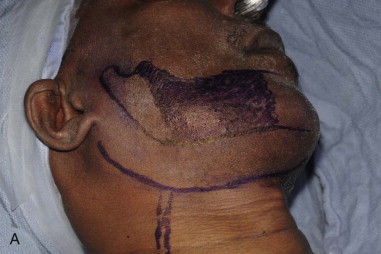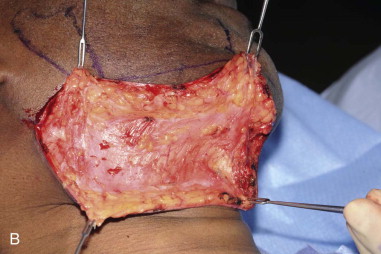Armamentarium
|
History of the Procedure
Mandibular resections in the first half of the twentieth century were rarely reconstructed, leading to obvious facial deformities. The term Andy Gump deformity was used to describe the appearance of patients who underwent anterior mandibular resection without reconstruction. The character Andy Gump was portrayed as an antihero in U.S. comic strips from 1917 to 1959 and is characteristically drawn with a large nose and mustache, but completely lacking a mandible. Early descriptions of mandibular resection and reconstruction or fixation in the literature used similar techniques for the resection but differed in immediate reconstruction. In 1942, Brown and McDowell described the use of Kirschner wires to fixate the mandible after resection. In 1945, McQuillan and colleagues described the use of a cobalt chrome implant fixated with screws, with the implant lasting 1 year. This was followed by several other surgeons using cobalt chrome or alloys, which lasted from 1 to 5 years. Additional reconstructive methods included the use of maxillomandibular fixation for several months followed by stainless steel wiring of blocs of iliac crest in the defect. The more recent development of rigid internal fixation has increased the success of, and ability to, reconstruct large segmental defects of the mandible.
History of the Procedure
Mandibular resections in the first half of the twentieth century were rarely reconstructed, leading to obvious facial deformities. The term Andy Gump deformity was used to describe the appearance of patients who underwent anterior mandibular resection without reconstruction. The character Andy Gump was portrayed as an antihero in U.S. comic strips from 1917 to 1959 and is characteristically drawn with a large nose and mustache, but completely lacking a mandible. Early descriptions of mandibular resection and reconstruction or fixation in the literature used similar techniques for the resection but differed in immediate reconstruction. In 1942, Brown and McDowell described the use of Kirschner wires to fixate the mandible after resection. In 1945, McQuillan and colleagues described the use of a cobalt chrome implant fixated with screws, with the implant lasting 1 year. This was followed by several other surgeons using cobalt chrome or alloys, which lasted from 1 to 5 years. Additional reconstructive methods included the use of maxillomandibular fixation for several months followed by stainless steel wiring of blocs of iliac crest in the defect. The more recent development of rigid internal fixation has increased the success of, and ability to, reconstruct large segmental defects of the mandible.
Technique: Lateral Mandibular Resection
Step 1:
Preparation
The sterile field should include both sides of the face and neck as well as landmarks for the orientation and monitoring of facial nerve function, including the ear lobe posteriorly and the oral commissure and chin anteriorly. Including a wide area in the sterile field allows for ease in extending the resection if clinically indicated without the need to reprep and drape. If the oral cavity is to be entered (typically resections involving tooth-bearing areas), this should be anticipated and the necessary extractions and arch bar placement performed prior to prepping. The anesthesia provider should be made aware that muscle relaxant use during induction should be short-acting in nature, as monitoring of facial nerve function intraoperatively could be rendered impossible. Also, injection of local anesthetic with a vasoconstrictor deep to the level of the platysma can affect conduction of the facial nerve ( Figure 85-1, A ).
Stay updated, free dental videos. Join our Telegram channel

VIDEdental - Online dental courses




